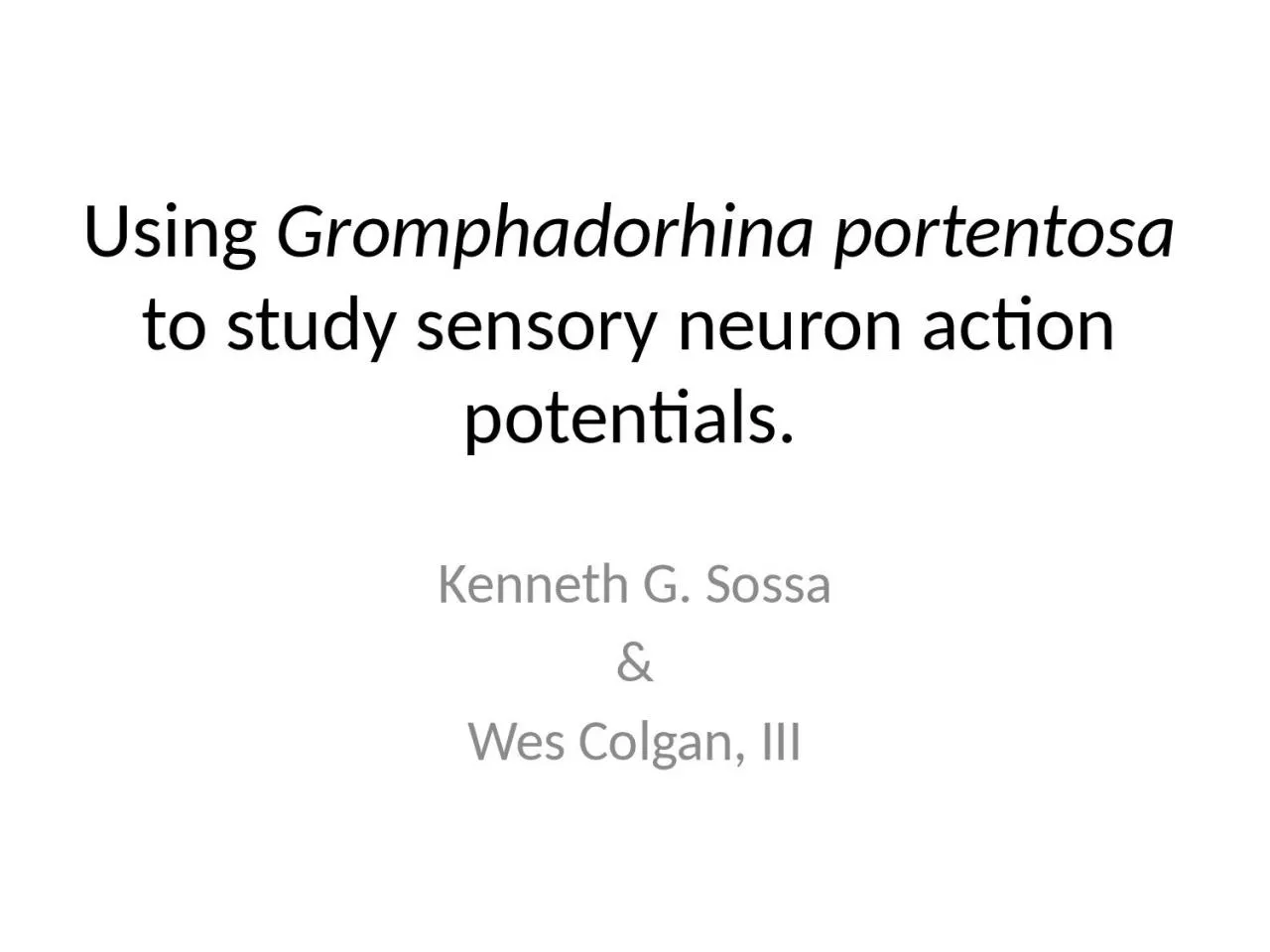

to study sensory neuron action potentials Kenneth G Sossa amp Wes Colgan III Neuroscience Love and Motivation Trained mammalian neuroscientist working at an institution without a ID: 932341
Download Presentation The PPT/PDF document "Using Gromphadorhina portentosa" is the property of its rightful owner. Permission is granted to download and print the materials on this web site for personal, non-commercial use only, and to display it on your personal computer provided you do not modify the materials and that you retain all copyright notices contained in the materials. By downloading content from our website, you accept the terms of this agreement.
Slide1
Using Gromphadorhina portentosa to study sensory neuron action potentials.
Kenneth G.
Sossa
&
Wes
Colgan
, III
Slide2Neuroscience: Love and MotivationTrained mammalian neuroscientist working at an institution without a vivarium
Explored simple model organisms for use in the teaching and research laboratory
Physiology labs needed at ABLE
Slide3Pre-Laboratory Quiz1. Sensory receptors detect changes, called ________, which occur inside and outside the body.
melanin
skin
motor
stimuli 2. Neurons that conduct impulses from the receptors to the central nervous system are called:motor neurons.efferent neurons.interneurons.sensory neurons. 3. All of the following are functions of the nervous system except:Sense changes in the environment.Analyze changes in the environment.Store calcium from the environment.Respond to changes in the environment. 4. The different charge between the outside and the inside of a neuron at rest is called:action potential.synaptic potential.resting membrane potential.equilibrium potential. 5. Before an action potential is generated the cell must reach its:polarization.repolarization.threshold. the resting period. 6. How does the nervous system send and receive messages?It uses electrical impulses.It uses chemicals.It uses both electrical impulses and chemicals.None of the above
Slide4Excitable Cells: NeuronsAnatomy & Function of a neuron
Types of neurons
Types of stimuli
Membrane Potential
Ions (Na+, K+)Leak channelsVoltage-gated channelsActive Transport (Na+/K+ pump)
Slide5Nervous System Transmission
Stimuli
Sensory Neurons
Ventral Nervous
SystemMotor NeuronsMovementAfferent InfoEfferent Command
Action Potential (
uV
)
Time (ms)
Afferent info recorded as
extracellular responses
or action potentials
Slide6What simple model organism could I use in my physiology lab?
The cockroach!
Gromphadorhina
portentosaGiant Madagascar Hissing Cockroach
Slide7Benefits of the “hisser” in the labInexpensiveEasy to maintain
Well established model organism
Not regulated by federal bodies or institutional committees
Larger size makes for easier dissections
Possibility of numerous types of experiments: genetic, biochemical, physiological, behavioral, etc.
Slide8Presented at ABLE (U of Oregon) & Society for Neuroscience
Sossa
KG. 2015. Using
Gromphadorhina portentosa
in the biology laboratory. Tested Studies for Laboratory Teaching. Volume 36 Article 80
Slide9Gromphadorhina portentosaThe Giant Madagascar Hissing Cockroach
Slide10Cockroach Leg Anatomy
Slide11Sensory Neuron
Ventral Nerve Cord
Neuronal transmission results in integration and efferent signal
Cockroach Central Nervous System
Brain
Thoracic
Ganglia
Abdominal
Ganglia
Sensory Neuron Axon
Interneuron
Motor Neuron
Leg Sensory Spine System
Slide12Sensory experience processing
Central Nervous System
Experience Detected by PNS and Relayed to CNS
Leg
Sensory
Neuron
Axon delivers info
Dendrite
Receives
info
Slide13Lab ObjectivesRecord and measure cockroach extracellular action potentialsMeasure the effect on cockroach extracellular action potentials when applying stimuli to sensory spines
Stimulate different spines and plot action potential magnitudes in a frequency histogram to compare the evoked responses
Describe sensory nerve adaptation
Slide14Cockroach Preparation, Recording Setup, Results, & Analysis
Histogram
Bins of Action Potentials (
uV
)Number of Events (Total#)AnesthetizeRoachIn Freezer*&DissectRoach LegPinned LegFor RecordingExample RecordingIndividualResponse*Anesthetize the cockroach at -20°C for 10-20 minutesDAQ->Software
Slide15Introduction, Equipment Setup, & Cockroach Preparation
Slide16Exercise 1:Exploring different stimuli
Slide17Exercise 2:Stimulating different sensory spines
Slide18Exercise 3:
Angle of Deflection
Slide19Exercise 4:Sensory Adaptation
Slide20Page 12: Report is generatedEmailed or Saved
Slide21Review Exercise Questions and Answers
Slide22Thanks toADInstruments, Inc. (images, screenshots, etc.)
University of Houston (
Powerlabs
, dissection tools, laptops, facilities)
Notre Dame of Maryland University (microhook electrodes, pins, cockroaches)
Slide23Questions?